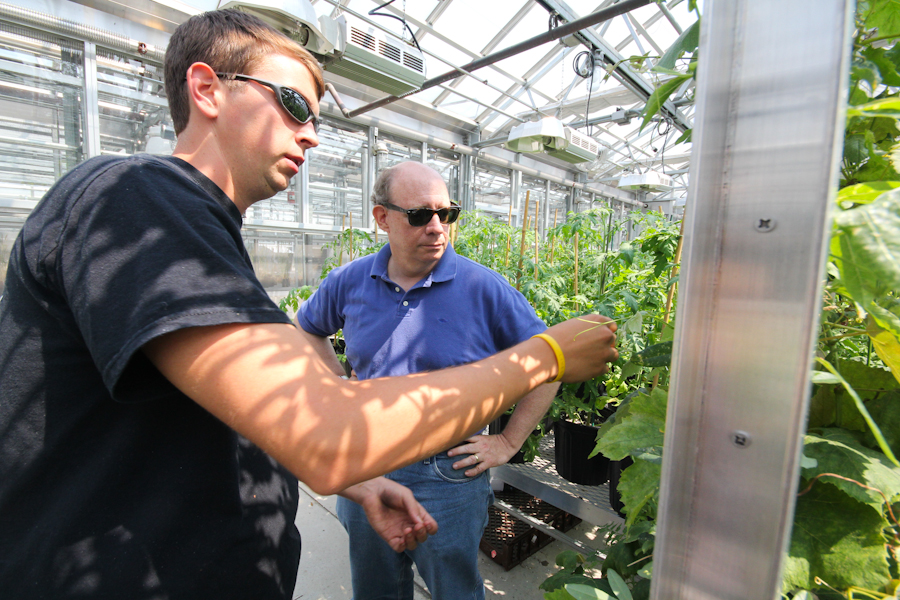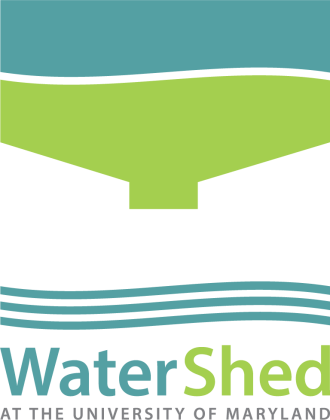
Scott Tjaden with Faculty Mentor Mike Binder
Photo Credit: Jeff Gipson
No one is more excited about the amount of green in WaterShed’s design than Scott Tjaden. An Environmental Science and Technology major, Scott looks at working on WaterShed as an opportunity to apply his background and skills to make a unique contribution to Maryland’s entry. “Ever since the beginning of working on this project, I could feel a want for a greater environmental influence on the project,” says Scott. “In years past, landscape and ‘green things’ were just an add-on item that didn’t get incorporated with other systems on the house.”
Scott’s ingenuity, passion, and enthusiasm were infectious with his teammates, who were keen to embrace his vision. Over the months he sifted, refined, and tweaked a variety of ideas. There were some trials and some errors, but Scott was a trooper throughout, always rolling with the punches. When the dust settled, WaterShed’s living systems came into focus: a green roof to slow runoff and help insulate the house, green walls to provide shade and food, and a major focal point, the constructed wetlands that filtrate runoff and greywater. Designed and nurtured from a terrific idea, this is Scott’s most significant contribution to the project. He talks about that and the many other rewards of WaterShed below.
What has been your personal WaterShed moment so far?
ST: Once everything was in place for filming on-site, it finally hit me it had all come together. After creating a number of different designs for the wetlands over the many months, they were finally built, they were in place, connected to the house, filled with plants, and operating. For the first time, this allowed me to see the wetlands from inside the house and through the shower, not a rough sketch or drawing. The wait was worth it, and it’s only going to get better once we are on the Mall with everything in its place for the competition.
Another highlight would be all of the plants our Living Systems team has grown. I personally have never taken a plant science class, yet have grown some great looking wetland plants. This was with the help from some local nurseries that provided the plants for us in the early spring of 2011. Seeing these plants when we first received them in 2” plugs with a height of about 4”, and now seeing some of them at 7’ tall and green as can be (going to knock on wood so my luck does not run out), combined with long and late night planting events with help from some of the team, is one of my biggest highlights so far.
Talk about an unexpected, amazing, frightening, or unlikely experience while working on WaterShed.
ST: An amazing experience would have to be when we were down in Florida for the International Builders Show in January of this year. We had an opportunity to show our model of the house to the crowds of people who visited the convention, which consisted of trades people and contractors. While standing with the model, many people came up and were in awe of the message and the design. After working on the project, at this point for almost a year, it didn’t seem like that big of a deal (seeing and saying the same thing over and over), but for these people seeing it for the first time it was amazing to them. After having this experience it helped me realize how big this project is and what an impact it may have on what people do within their own homes. This made me feel great and put that much more effort into the project to make it stand out from the rest.
What has been your most important learning experience on the project?
ST: This project has actually shown me how important it is to physically go outside your academic program and interact with other disciplines. I have learned so much from this project that normally through the standard curriculum for my major I would not have. This hands on experience has allowed me to apply what I have learned and incorporate it with other disciplines. Not only me learning from others, but also the fact I am passing my knowledge of environmental ‘things’ onto the immediate team, and eventually the public, who will visit in September.
Has working on WaterShed influenced your career path at all, and if so, how?
ST: Working on WaterShed has opened my eyes to a potential consulting job within the building industry. I have seen through the whole process how my environmental background has made a direct and in-direct impact on the project. If I can use my environmental background to help improve the way we live within society with less of an impact on the environment would be very rewarding. I am still planning on going to graduate school to focus on energy and the many factors that come with renewable energy.
When people come to visit WaterShed on the Mall in September, what do you hope they will take away from the experience?
ST: I hope the public takes away WaterShed’s main message: water conservation. The many features of the house can be implemented on previously built homes or put in the design of new homes. The changes made to a home can be as small as changing to a lower-flow showerhead all the way up to installing solar-thermal on the homeowner’s roof. Another key point would be energy production on-site, reducing the need for energy produced off-site from non-renewable sources. This allows the home owner to have control over what pollutants they put into their environment, through air pollution and water pollutants through runoff.
Also, I hope people see the broader picture of the whole Solar Decathlon competition, how all these Universities from around the world spend two years planning and building a house to show homes can be built in a smarter way. There is a significant amount of research and time that goes into these homes, showing the creativity and how the community, industry, and many different trades can work together to improve the way homes are built for the future.
What do you always have with you on the job site?
ST: A construction pencil and a Utility knife.
How do you spend your time when you’re not on the job site?
ST: I spend a lot of time up in the greenhouse tending to the MANY plants. Other than that, should be getting ready for the GRE.
